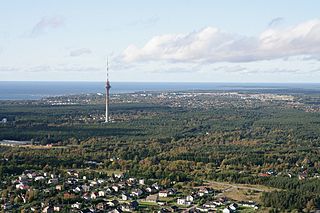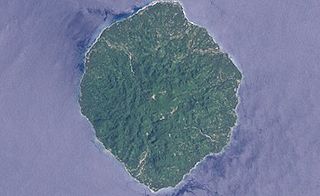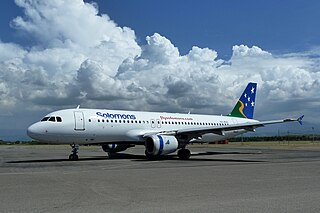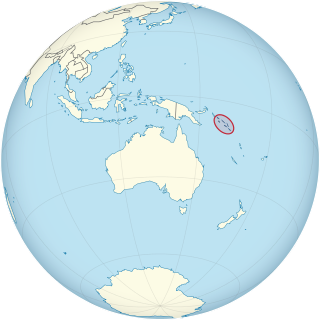
Solomon Islands is a sovereign state in the Melanesia subregion of Oceania in the western Pacific Ocean. This page is about the history of the nation state rather than the broader geographical area of the Solomon Islands archipelago, which covers both Solomon Islands and Bougainville Island, a province of Papua New Guinea. For the history of the archipelago not covered here refer to the former administration of the British Solomon Islands Protectorate, the North Solomon Islands and the History of Bougainville.

Guadalcanal is the principal island in Guadalcanal Province of Solomon Islands, located in the southwestern Pacific Ocean, northeast of Australia. It is the largest island in the Solomons by area and the second-largest by population. The island is mainly covered in dense tropical rainforest and has a mountainous hinterland.

Solomon Islands, also known simply as the Solomons, is a country consisting of six major islands and over 900 smaller islands in Melanesia, part of Oceania, to the northeast of Australia. It is directly adjacent to Papua New Guinea to the northwest, Australia to the southwest, New Caledonia and Vanuatu to the southeast, Fiji, Wallis and Futuna, and Tuvalu to the east, and Nauru and the Federated States of Micronesia to the north. It has a total area of 30,407 square kilometres, and a population of 734,887 according to the official estimates for mid 2023. Its capital, Honiara, is located on the largest island, Guadalcanal. The country takes its name from the wider area of the Solomon Islands archipelago, which is a collection of Melanesian islands that also includes the Autonomous Region of Bougainville, but excludes the Santa Cruz Islands.

Tallinn TV Tower is a free-standing structure with an observation deck, built to provide better telecommunication services for the 1980 Moscow Summer Olympics regatta event. It is located near the suburb Pirita, six km north-east of the Tallinn city center. With its 313 m (1030.2 ft), the TV tower is the tallest nonbuilding structure in Tallinn. The tower was officially opened on 11 July 1980. The viewing platform at a height of 170 metres was open to the public until 26 November 2007, when it was closed for renovation. The tower began receiving visitors again on 5 April 2012. The building is administered by the public company Levira and is a member of the World Federation of Great Towers.

Savo Island is an island in the Solomon Islands in the South Pacific ocean. Administratively, Savo Island is a part of the Central Province of the Solomon Islands. It is about 35 kilometres (22 mi) from the national capital of Honiara. The principal village is Alialia, in the north of the island.

The Scottish Parliament Building is the home of the Scottish Parliament at Holyrood, within the UNESCO World Heritage Site in central Edinburgh. Construction of the building commenced in June 1999 and the Members of the Scottish Parliament (MSPs) held their first debate in the new building on 7 September 2004. The formal opening by Queen Elizabeth II took place on 9 October 2004. Enric Miralles, the Catalan architect who designed the building, died before its completion.

New Zealand Parliament Buildings house the New Zealand Parliament and are on a 45,000 square metre site at the northern end of Lambton Quay, Wellington. From north to south, they are the Parliamentary Library building (1899); the Edwardian neoclassical-style Parliament House (1922); the executive wing, called "The Beehive" (1977); and Bowen House. Whilst most of the individual buildings are outstanding for different reasons, the overall setting that has been achieved "has little aesthetic or architectural coherence".

Guadalcanal Province is one of the nine provinces of Solomon Islands, consisting of the island of Guadalcanal. It is a 2,510 square mile (5,336 km2) island and is largely a jungle. Its name was given by Pedro de Ortega Valencia, born in the village of Guadalcanal, Seville, Spain. The national capital and largest city of the Solomon Islands, Honiara, is on the island; in July 1983, it was designated a 22 km2 (8.5 sq mi) separately-administered Capital Territory and is no longer considered part of the province. The population of the province is 93,613 (2009), not including the capital territory. The population of the island is 161,197. Honiara serves as the provincial capital. The climate is rainforest tropical. The estimated terrain elevation above sea level is 447 meters (1,467 ft).

Honiara International Airport, formerly known as Henderson Field, is an airport in the province of Guadalcanal in the nation of Solomon Islands. It is the primary international airport in the country, the second being Munda Airport in Western Province, which serves as its alternate. It is located 8 kilometres from the capital, Honiara.

Henderson Field is a former military airfield on Guadalcanal, Solomon Islands during World War II. Originally built by the Japanese Empire, the conflict over its possession was one of the great battles of the Pacific War. Today it is Honiara International Airport.
Munda International Airport is an international airport adjacent to the town of Munda, Western Province in Solomon Islands.

The Cube is a 24-storey mixed-use development in the centre of Birmingham, England. Designed by Ken Shuttleworth of Make Architects, it contains 135 flats, 111,500 square feet (10,359 m2) of offices, shops, a hotel and a 'skyline' restaurant. It is the final phase of The Mailbox development.

Solomon Islands – United States relations are bilateral relations between Solomon Islands and the United States. Initial relations were forged during World War II with what was then the British Solomon Islands Protectorate during the Japanese occupation, and this relationship remained strong as Solomon Islands gained its independence in 1978. Relations continued until 1993 when post-Cold War budget cuts closed the United States Embassy in Honiara. Beginning in 2022, in an attempt to counter growing Chinese influence in Solomon Islands, the United States has demonstrated increased commitment to the restoration of relations with the country. In February 2023, the United States re-opened its embassy in Honiara.

The following outline is provided as an overview of and topical guide to Solomon Islands:

Honiara is the capital and largest city of Solomon Islands, situated on the northwestern coast of Guadalcanal. As of 2021, it had a population of 92,344 people. The city is served by Honiara International Airport and the seaport of Point Cruz, and lies along the Kukum Highway.

Point Cruz is a peninsula in the center of Honiara, on Guadalcanal Island. Honiara is the capital city of the Solomon Islands. Point Cruz is located on the Tandai Highway, and is ¼ mile north of the Solomon Islands Parliament Building. Point Cruz is in the Honiara City Council ward of Cruz, and is East of Town Ground and West of Tuvaruhu.

The St. Barnabas' Anglican Cathedral, Honiara is one of three Anglican cathedrals built in the Solomon Islands. The St. Luke's Cathedral was the first to be built in 1920s at Siota, Nggela but it was destroyed in World War II. The second was the All Saints Cathedral, a temporary structure built in the 1950s which was replaced by the St. Barnabas' Anglican Cathedral, Honiara, named after the St. Barnabas' Chapel and School on Norfolk Island, in the 1960s; the planning to build it started in 1961. The foundation stone for the new cathedral was laid on 6 January 1968 by Bishop Alfred Hill. A dedication service was held on 15 December 1968 which was attended by 1500 people. The cathedral was formally consecrated on 16 June 1969 when 2000 people attended the ceremony and it was dedicated by Bishops Chisholm and Alufurai.

Vuhokesa is a suburb in Honiara located in the main center on the Tandai Highway and includes the City Council roundabout. Vuhokesa is in the Honiara City Council ward of Vavaea. and is East of Point Cruz and West of Lord Howe Settlement. The Vuhokesa border is the West bank of the Mataniko River which runs into Kua Bay.

On 5 June 2000, a coup d'état occurred in Solomon Islands, in the capital of Honiara, in which the prime minister, Bartholomew Ulufa’alu, was taken hostage by militants of the Malaita Eagle Force. The event came as a result of longstanding ethnic tensions between the province that saw a rise in armed political groups from the late 1990s.

US Naval Base Solomons was a number of United States Navy bases in the Solomon Islands in the Pacific Ocean. Most were built by the US Navy Seabees, Naval Construction Battalions, during World War II as part of the Pacific War. In August 1942 the United States Armed Forces took the Guadalcanal in the Solomon, in the Battle of Guadalcanal. US Navy Seabees built a new base at Guadalcanal, Naval Base Guadalcanal and then on other islands in the Solomons.





















